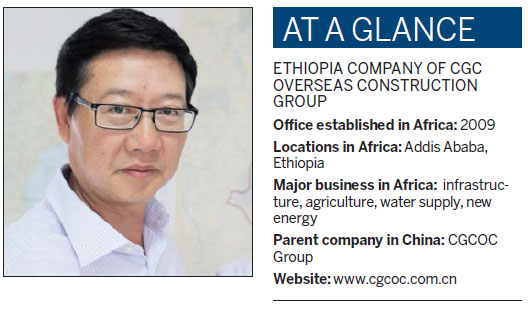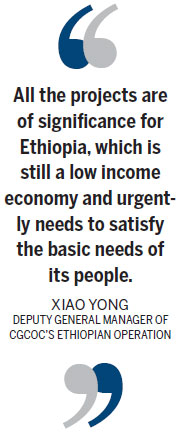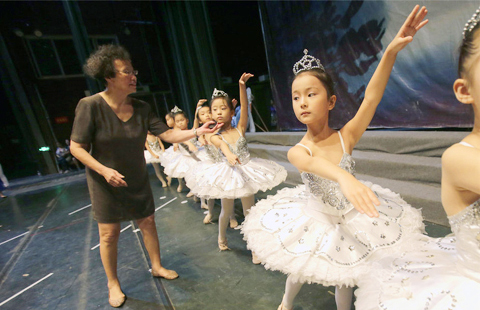
Chinese construction firm has brought equipment and know-how to help Ethiopia
On the outskirts of Ethiopia's second largest city, Adam, there is a stunning example of ancient methods meeting modern technology.
More than 100 three-blade wind turbines contrast dramatically with the agricultural backdrop of the East Africa rift valley, which has remained virtually unchanged for centuries.
|
A boy herds cattle near the wind power farm constructed by China's CGC Overseas Construction Group in Adam, Ethiopia. Fu Jing / China Daily |

Under the turbines, farmers still happily plant crops, or raise their cows or horses.
"The blend of smart energy and traditional farming is stunningly beautiful, and it has contributed significantly to Ethiopia's development," says Wang Wencai, who is in charge of the wind power project, being completed by China's CGC Overseas Construction Group.
When the two-phase, 200 mW wind farm hits full capacity, it will be the country's largest wind project.

Authorized by the Ethiopian Energy Authority, and financed with a low-cost $468 million loan from China, the site is being co-managed by CGCOC and its partner Hydro China.
Xiao Yong, the deputy general manager of CGCOC's Ethiopian operation, says the Chinese company is also involved in water supply projects across the country, and glass production.
"All the projects are of significance for Ethiopia, which urgently needs to satisfy the basic needs of its people."
The land-locked country lacks energy and mineral resources, adds Xiao, who says CGCOC has worked hard at researching the best ways to match China's strengths with the country's needs, particularly in relation to poverty reduction and economic growth.
The wind farm is a perfect example: Ethiopia is rich in wind resources while China has gathered tremendous experience in building major wind projects from scratch.
"What's more, China can also offer low-cost financial support to such clean-energy projects," Xiao says.
His company has ambitious plans to persuade the Ethiopian authorities to expand their wind power capacity much further, using Chinese know-how, and its Rift Valley region offers the perfect sites, he says.
"We have submitted proposals to the Ethiopian government and so far the feedback has been positive."
He goes as far as suggesting that he and his company have ambitions to turn the country into what he calls a "green energy larder", based on wind and water-generated power.
Elsewhere in Ethiopia, France has also built a 120 mW wind farm, but it used mainly two-blade turbines, which many in the industry, including those in Ethiopia, now consider technology of the 1990s.
The company is already considering requests from the Ethiopians to offer its wind power technology to local companies, to significantly improve not only its home-grown renewable capability, but also its ability to sell that abroad.
Originally, CGCOC specialized in drilling water wells in various African countries, and so far it has built five water supply plants in Ethiopia, four of which are in the suburbs of Addis Ababa.
Financed with loans from both the World Bank and the Chinese government, the new plants have so far provided water for 3 million Ethiopians.
"Ethiopia is rich in underground water, but it is very deep, often at 500m, and this is very difficult for Ethiopians to drill," says Yu Renzhi, who is in charge of CGCOC's water supply projects.
"But we have been able to improve the drilling capabilities of our local partners."
Yu has been in the country since 2005, at a time when water drilling activities were dominated by European or US companies.
Local involvement in every project it completes is crucial, Yu says, at every stage.
"We are keen to train local workers and transfer our drilling skills and construction know-how," he says.
During the building of those five water plants, thousands of local people were employed, and at their peak around 5,000 were working full-time.
"We also want to transfer our management know-how in water supply to local people, and that will continue, as we plan to work on further projects," Xiao says.
He adds that with its diverse ownership model, CGCOC has the flexibility to further deepen its cooperation with partners, both in China and Africa.

After arriving in Ethiopia in 2003, with an initial investment of $200,000, CGCOC now employs about 10,000 locally.
Ato Zemedkun Asfaw, human resources manager of its Ethiopia branch, says he and his co-workers have benefited from their Chinese employer's involvement in the country.
He adds that over the past decade, China has brought great changes to Ethiopia, much more so than in the years when Western companies dominated much of the activity.
The other main strand to CGCOC's business in Ethiopia is its glass plant, built next door to its headquarters in Addis Ababa.
As many more Ethiopians move from the country into the cities, the demand for apartments is expected to soar.
Until 2009, the country's building industry was reliant on imported glass, 80 percent of which was coming from China.
"So we decided to build the country's first glass factory," says Yu Wenli, the facility's deputy general manger.
With an annual production capacity of 20,000 tons of glass, Yu says the operation has been a great success.
"It has helped save Ethiopia's foreign currency reserves, by replacing imported glass with locally produced, at the same time creating hundreds of local jobs."
fujing@chinadaily.com.cn
(China Daily Africa Weekly 08/15/2014 page20)








